
Chinese Journal of Applied Chemistry ›› 2025, Vol. 42 ›› Issue (1): 29-41.DOI: 10.19894/j.issn.1000-0518.240258
• Review • Previous Articles Next Articles
Research Progress in Design, Synthesis and Properties of Organic Octupolar Two-Photon Excited Fluorescence Materials
Liang XU1( ), Jian-Peng LIU2, Jian QING1
), Jian-Peng LIU2, Jian QING1
- 1.School of New Energy and Materials,Southwest Petroleum University,Chengdu 610500,China
2.College of Chemistry and Chemical Engineering,Shantou University,Shantou 515063,China
-
Received:2024-08-11Accepted:2024-10-26Published:2025-01-01Online:2025-01-24 -
Contact:Liang XU -
About author:liangxu@swpu.edu.cn
-
Supported by:the National Natural Science Foundation of China(52073167)
CLC Number:
Cite this article
Liang XU, Jian-Peng LIU, Jian QING. Research Progress in Design, Synthesis and Properties of Organic Octupolar Two-Photon Excited Fluorescence Materials[J]. Chinese Journal of Applied Chemistry, 2025, 42(1): 29-41.
share this article
Add to citation manager EndNote|Ris|BibTeX
URL: http://yyhx.ciac.jl.cn/EN/10.19894/j.issn.1000-0518.240258
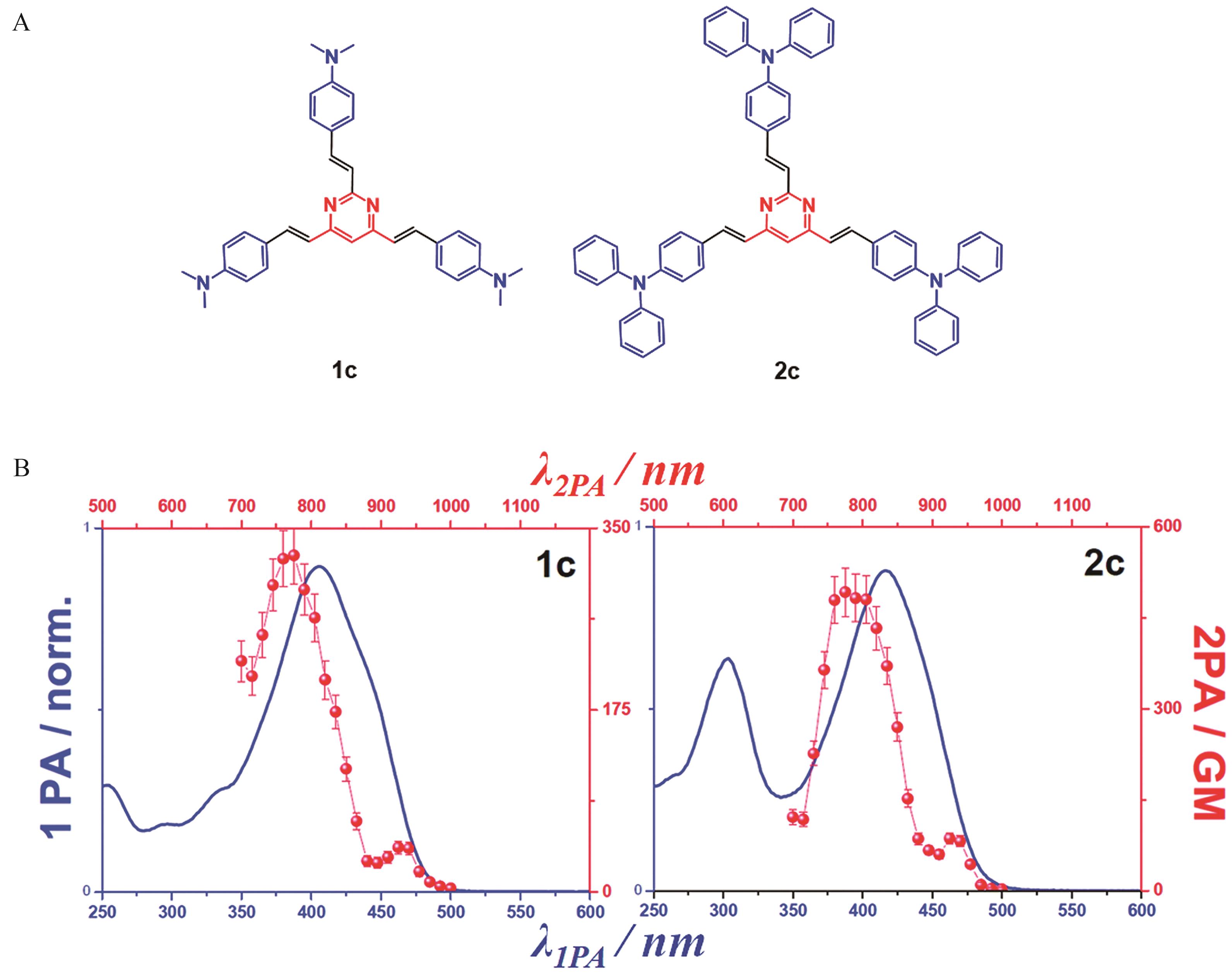
Fig.1 (A) The molecular structure of octupolar molecules 1c and 2c; (B) One-photon (full line) and two-photon (dots) absorption spectra of octupolar molecules 1c and 2c in dichloromethane, where the lower abscissa represents the one-photon absorption wavelength, the upper abscissa represents the two-photon absorption wavelength, and the ordinate represents the two-photon absorption cross section[20]
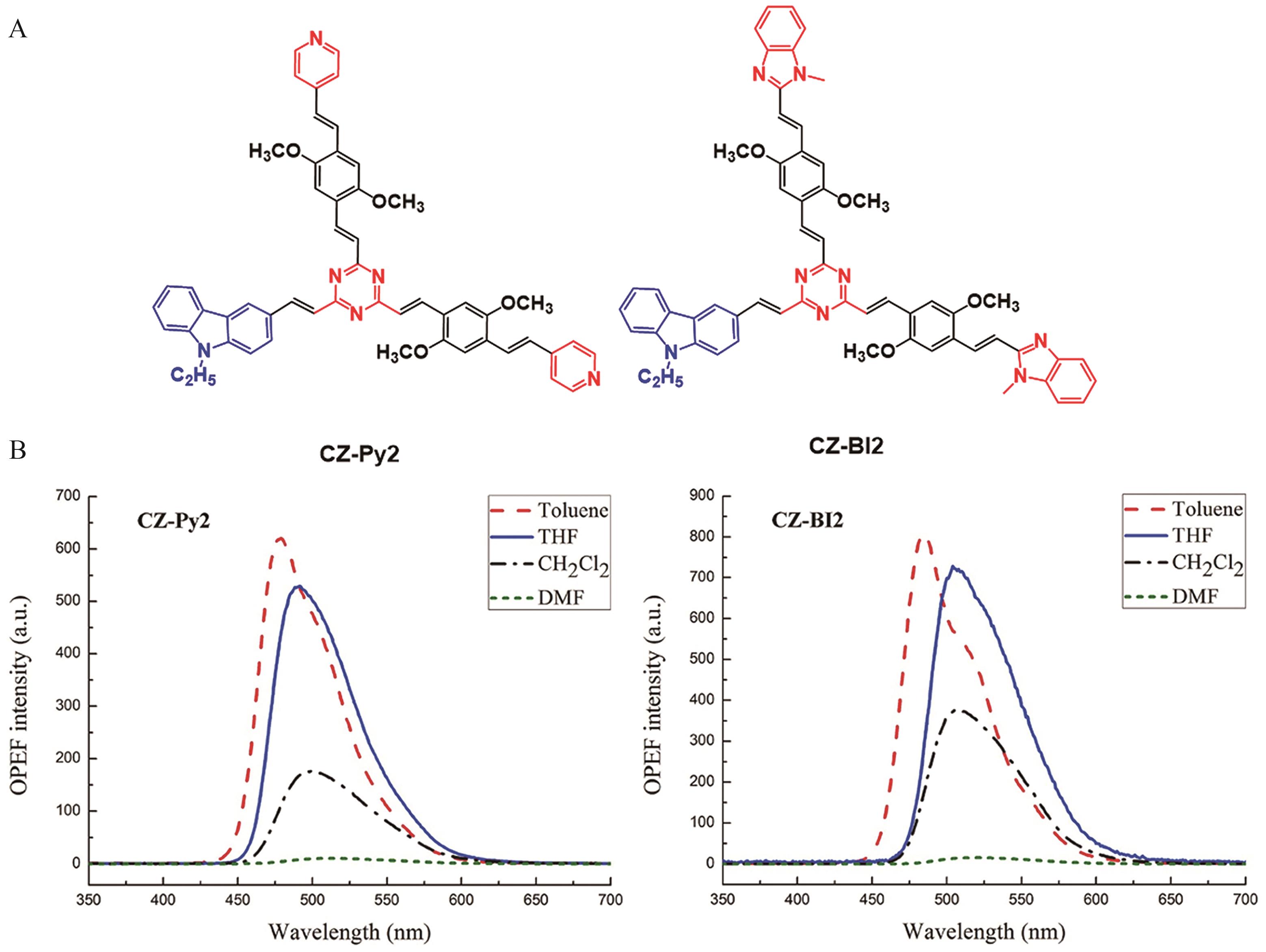
Fig.2 (A) The molecular structure of octupolar molecules CZ-Py2 and CZ-BI2; (B) One-photon excited fluorescence spectra of octupolar molecules CZ-Py2 and CZ-BI2 in different polar solvents (toluene, tetrahydrofuran, dichloromethane, N,N'-dimethylformamide)[22]
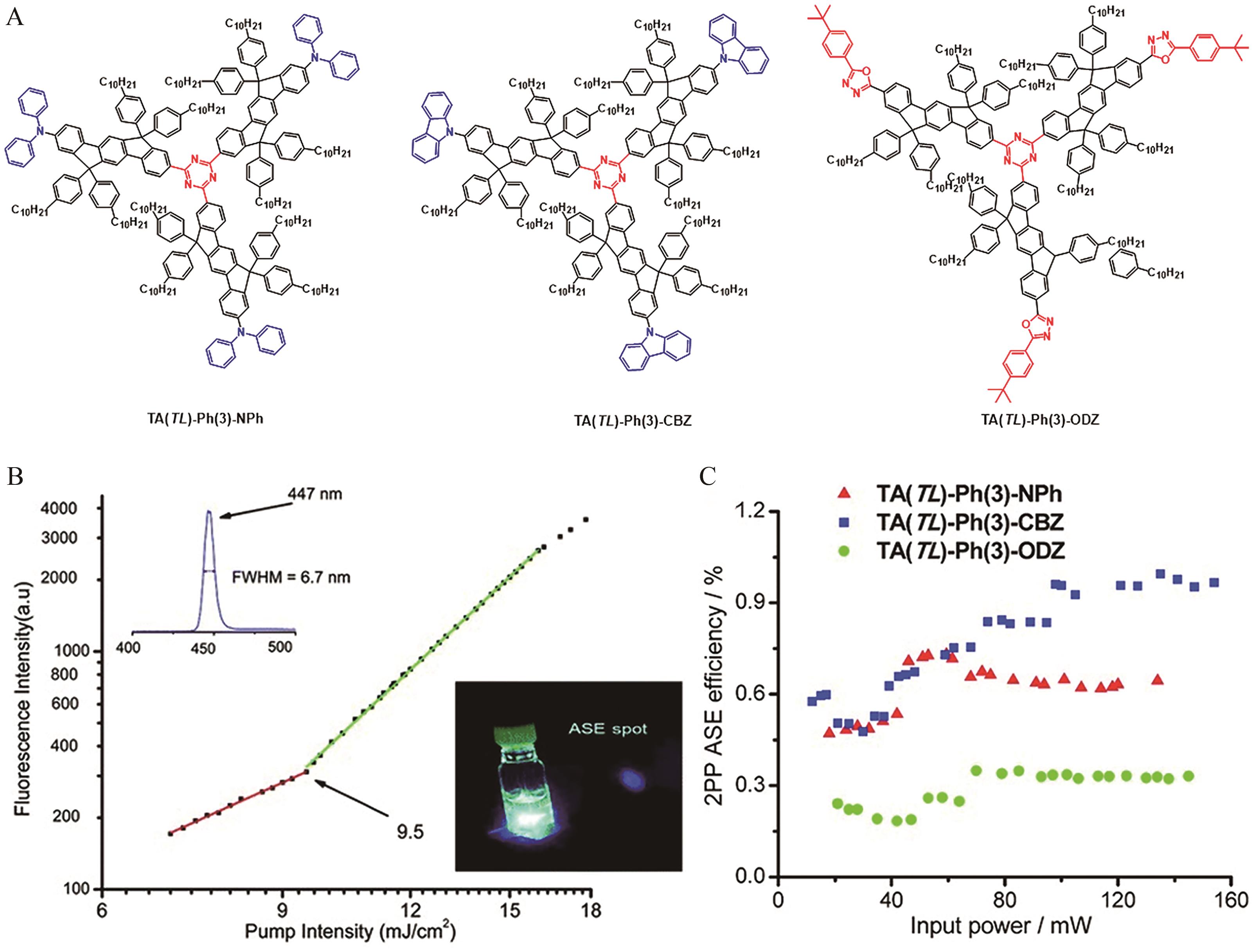
Fig.3 (A) The molecular structure of octupolar molecules TA?(TL)?-Ph?(3)?-NPh, TA?(TL)?-Ph?(3)?-CBZ and TA(TL)-Ph(3)-ODZ; (B) Plots of integrated emission intensity vs. input pumping energy for TA(TL)-Ph(3)-CBZ in toluene. Inset: 2PP ASE spectrum of TA(TL)-Ph(3)-CBZ in toluene; (C) Plots of the 2PP ASE efficiency versus the input pumping intensity at 800 nm[27]
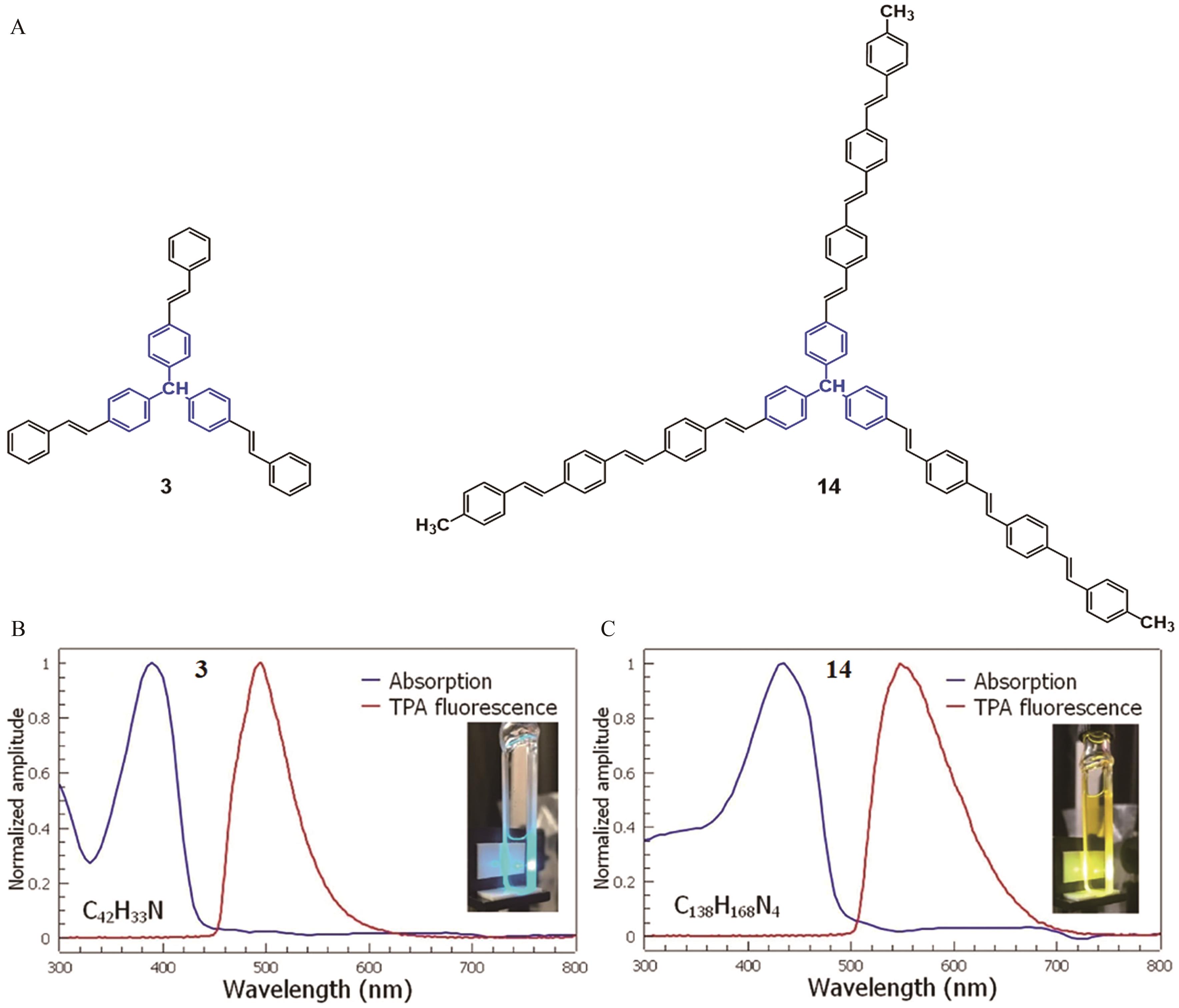
Fig.4 (A) The molecular structure of octupolar molecules 3 and 14; (B) UV-Vis absorption and two-photon absorption (TPA) emission spectra of compounds 3 (C42H33N) (C) and 14 (C138H168N4) under the excitation of an 800 nm femtosecond laser. Insets of (B, C) are images of TPA fluorescent emission for two molecules with the same concentration[35]
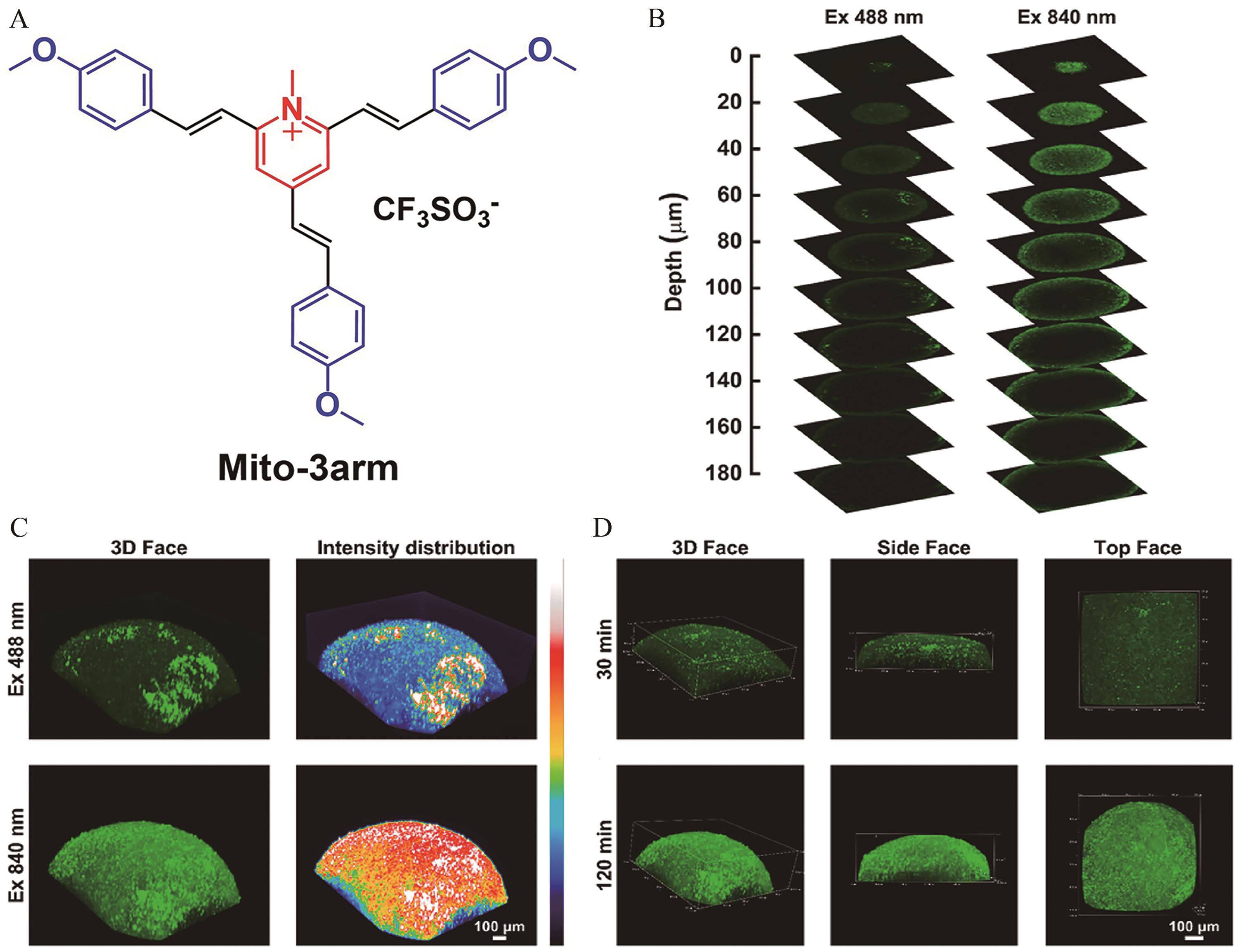
Fig.5 (A) The molecular structure of octupolar molecule Mito-3arm; (B) Z-stack confocal microscopy images of organoids stained with Mito-3arm were recorded at different imaging depths using one-photon (488 nm) or two-photon (840 nm) excitation; (C) One-photon (488 nm) or two-photon (840 nm) excitation, along with corresponding fluorescence intensity distribution maps, constructed by ImageJ; (D) Two-photon confocal microscopy images of organoids stained with Mito-3arm were obtained at 30 and 120 min[37]
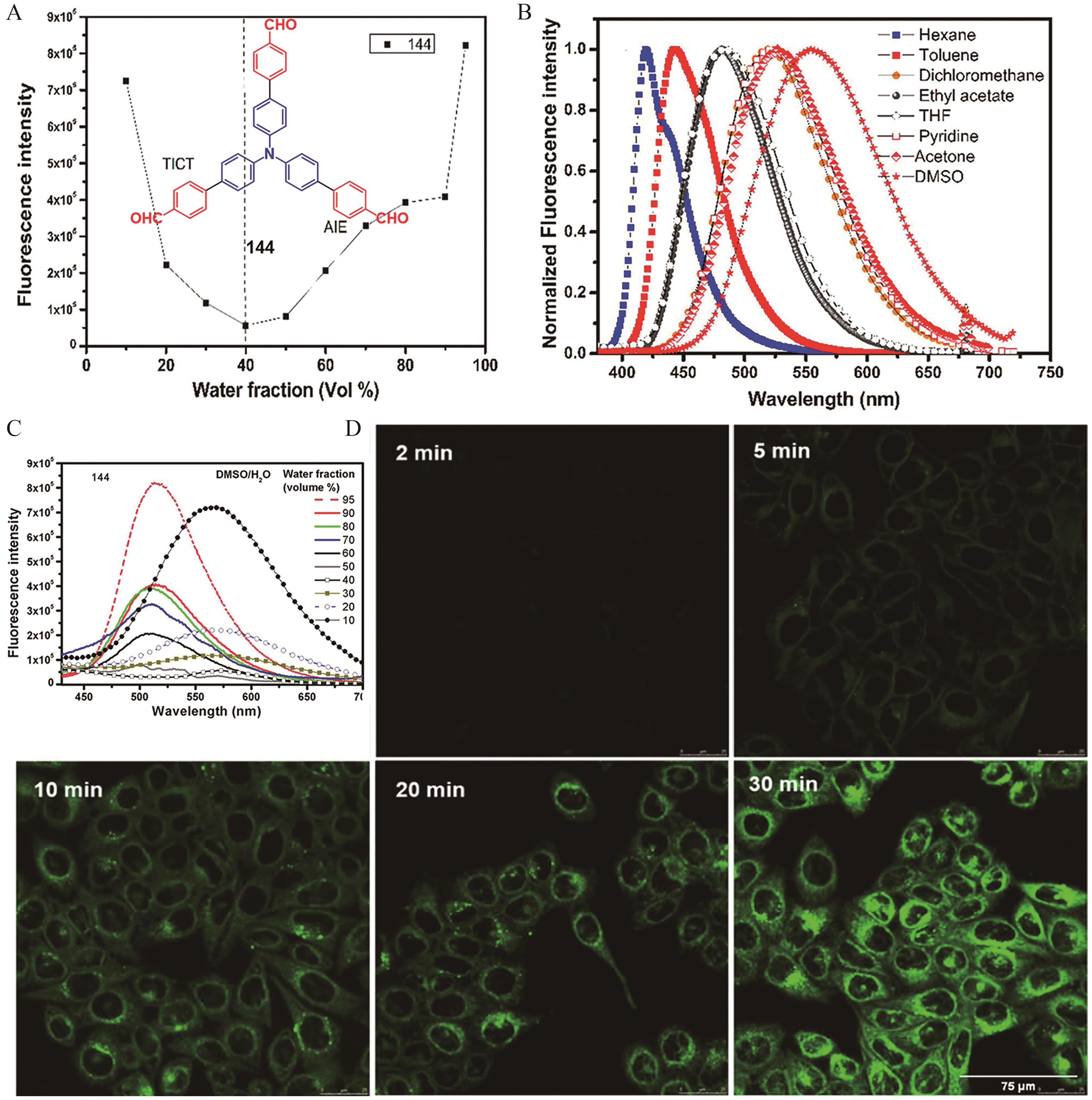
Fig.6 (A) Analysis of the change of fluorescence intensity of molecule 144 with the H2O fraction, inset: the molecular structure of octupolar molecule 144; (B) Fluorescence emission spectra of molecule 144 in different solvents with an excitation wavelength of 365 nm; (C) Fluorescence emission spectra of molecule 144 in DMSO/H2O with different ratios with an excitation wavelength of 365 nm; (D) Two-photon fluorescence imaging of HeLa cancer cells stained with BSA/144 excited at 820 nm with different incubation times[42]

Fig.7 (A) The molecular structure of octupolar molecule F and F2; (B) Two-photon absorption spectra of chromophores F and F2 in THF; (C) Preparation of fluorophore-based periodic mesoporous organosilica nanoparticles (F PMO NPs), including silylation process of fluorophore F and integration of resulting F—Si precursor in the sol-gel synthesis of E 4S F PMO NPs; (D) Two-photon fluorescence imaging of synthesized fluorophore-PMO NPs[44]
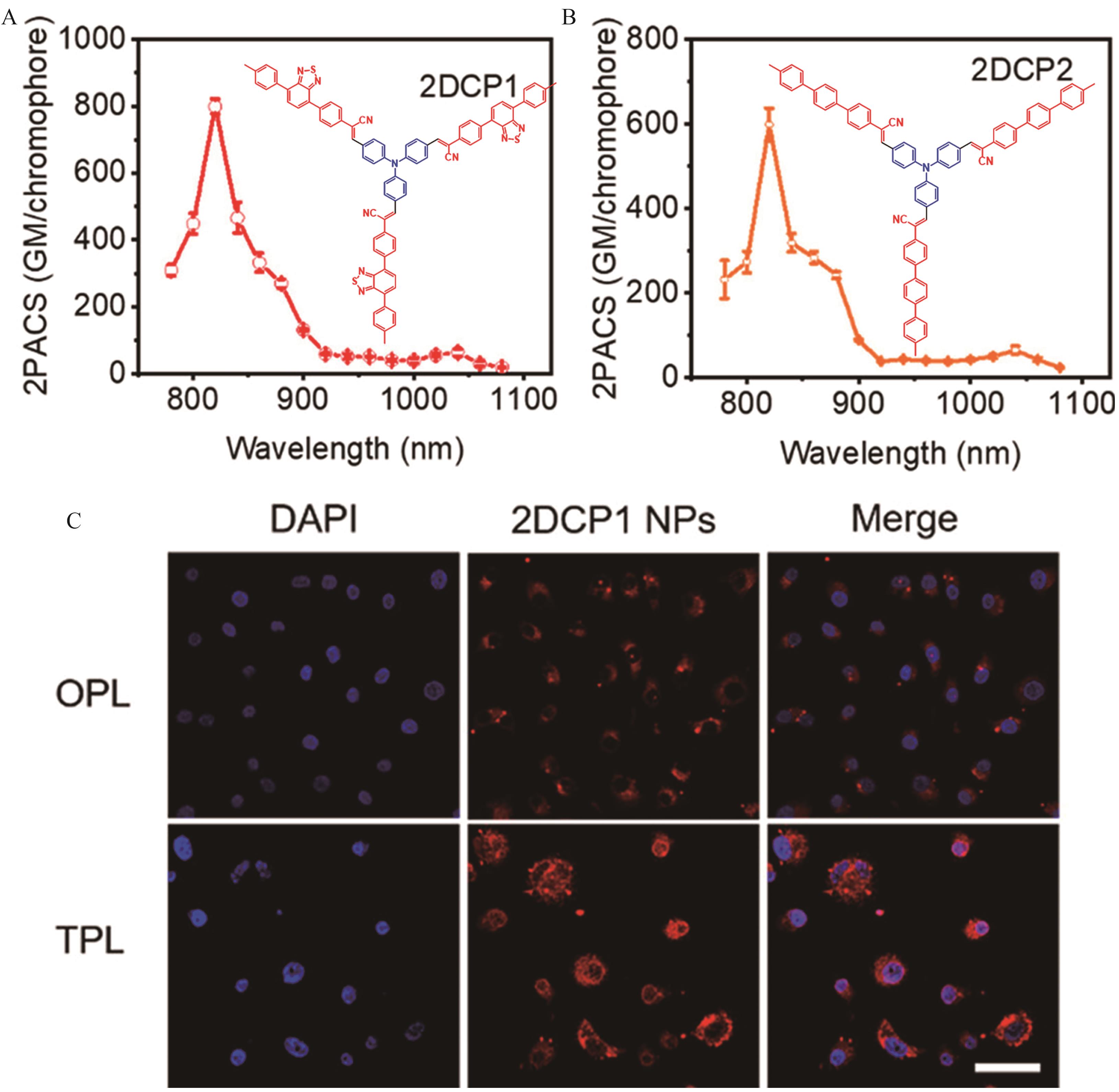
Fig.8 (A) The octupolar molecular structure of 2DCP1 and the two-photon action cross section of 2DCP1 under an excitation wavelength of 780~1080 nm; (B) The octupolar molecular structure of 2DCP2 and the two-photon action cross section of 2DCP2 under an excitation wavelength of 780~1080 nm; (C) Confocal laser scanning microscope images of 4T1 cells treated with 2DCP1 NPs excited by one- and two-photon excitation (scale bar: 50 μm)[46]
| 1 | WU L, LIU J, LI P, et al. Two-photon small-molecule fluorescence-based agents for sensing, imaging, and therapy within biological systems[J]. Chem Soc Rev,2021, 50(2): 702-734. |
| 2 | CHATTERJEE A, CHATTERJEE J, SAPPATI S, et al. Engineering TADF, mechanochromism, and second harmonic up-conversion properties in regioisomeric substitution space[J]. Chem Sci,2023, 14(47): 13832-13841. |
| 3 | HAO L, LIU F, WANG X, et al. Crystallography, charge transfer, and two-photon absorption relations in molecular cocrystals for two-photon excited fluorescence imaging[J]. Small,2024, 20(17): 2308470. |
| 4 | ZONG W, WU R, LI M, et al. Fast high-resolution miniature two-photon microscopy for brain imaging in freely behaving mice[J]. Nat Methods,2017, 14(7): 713-719. |
| 5 | ZONG W, WU R, CHEN S, et al. Miniature two-photon microscopy for enlarged field-of-view, multi-plane and long-term brain imaging[J]. Nat Methods,2021, 18(1): 46-49. |
| 6 | China's two-photon microscope captures cell images of astronauts in orbit[OL]. https://english.news.cn/20230227/4c20894032ed4528861ebcda13ba9ce4/c.html. |
| 7 | EVANS O R, LIN W. Crystal engineering of NLO materials based on metal-organic coordination networks[J]. Acc Chem Res, 2002, 35(7): 511-522. |
| 8 | BOIXEL J, GUERCHAIS V, LE BOZEC H, et al. Second-order NLO switches from molecules to polymer films based on photochromic cyclometalated platinum(Ⅱ) complexes[J]. J Am Chem Soc, 2014, 136(14): 5367-5375. |
| 9 | SUN C L, LI J, WANG X Z, et al. Rational design of organic probes for turn-on two-photon excited fluorescence imaging and photodynamic therapy[J]. Chem, 2019, 5(3): 600-616. |
| 10 | XU L, ZHANG J, YIN L, et al. Recent progress in efficient organic two-photon dyes for fluorescence imaging and photodynamic therapy[J]. J Mater Chem C, 2020, 8(19): 6342-6349. |
| 11 | PAWLICKI M, COLLINS H A, DENNING R G, et al. Two-photon absorption and the design of two-photon dyes[J]. Angew Chem Int Ed,2009, 48(18): 3244-3266. |
| 12 | CHO H J, KIM S W, KIM S, et al. Suppressing π-π stacking interactions for enhanced solid-state emission of flat aromatic molecules via edge functionalization with picket-fence-type groups[J]. J Mater Chem C, 2020, 8(48): 17289-17296. |
| 13 | XU L, LIN W, HUANG B, et al. The design strategies and applications for organic multi-branched two-photon absorption chromophores with novel cores and branches: a recent review[J]. J Mater Chem C, 2021, 9(5): 1520-1536. |
| 14 | FANG F, YUAN Y, WAN Y, et al. Near-infrared thermally activated delayed fluorescence nanoparticle: a metal-free photosensitizer for two-photon-activated photodynamic therapy at the cell and small animal levels[J]. Small, 2022, 18(6): 2106215. |
| 15 | NGUYEN V N, LEE D J, ZHANG D, et al. Rational design of efficient heavy-atom-free boron-dipyrromethene nanophotosensitizers for two-photon excited photodynamic therapy of cancer[J]. Chem Mater, 2024, 36(11): 5534-5541. |
| 16 | GRIESBECK S, MICHAIL E, RAUCH F, et al. The effect of branching on the one- and two-photon absorption, cell viability, and localization of cationic triarylborane chromophores with dipolar versus octupolar charge distributions for cellular imaging[J]. Chem Eur J, 2019, 25(57): 13164-13175. |
| 17 | NGUYEN T V, MAEDA T, MATSUYAMA T, et al. One-photon and two-photon absorption properties of multi-branched squaraine dyes comprised of triphenylamine cores and ethynylene linkers[J]. ChemPhotoChem, 2023, 7(11): e202300152. |
| 18 | ŠIMON P, KLIKAR M, BUREŠOVÁ Z, et al. Centripetal triazine chromophores: towards efficient two-photon absorbers and highly emissive polyimide films[J]. J Mater Chem C, 2023, 11(22): 7252-7261. |
| 19 | EL KAROUT H, ÖZKONSTANYAN A, SENTÜRK E, et al. Innovative triazine-core octupolar chromophores: unlocking new Frontiers in nonlinear optics[J]. J Mater Chem C, 2024, 12(30): 11458-11473. |
| 20 | KOURNOUTAS F, FIHEY A, MALVAL J P, et al. Branching effect on the linear and nonlinear optical properties of styrylpyrimidines[J]. PhysChemChemPhys,2020, 22(7): 4165-4176. |
| 21 | ZHANG L, ZOU L, XIAO J, et al. Symmetrical and unsymmetrical multibranched D-π-A molecules based on 1,3,5-triazine unit: synthesis and photophysical properties[J]. J Mater Chem,2012, 22(33): 16781-16790. |
| 22 | CAI Z B, CHEN L J, LI S L, et al. Synthesis, electronic structure, linear and nonlinear photophysical properties of novel asymmetric branched compounds[J]. Dyes Pigm,2020, 175: 108115. |
| 23 | GUO L, WONG M S. Multiphoton excited fluorescent materials for frequency upconversion emission and fluorescent probes[J]. Adv Mater, 2014, 26(31): 5400-5428. |
| 24 | HE G S, TAN L S, ZHENG Q, et al. Multiphoton absorbing materials: molecular designs, characterizations, and applications[J]. Chem Rev, 2008, 108(4): 1245-1330. |
| 25 | XU W, YI J, LAI W Y, et al. Pyrene-capped conjugated amorphous starbursts: synthesis, characterization, and stable lasing properties in ambient atmosphere[J]. Adv Funct Mater, 2015, 25(29): 4617-4625. |
| 26 | GUO L, LI K F, WONG M S, et al. Star-shaped ladder-type ter(p-phenylene)s for efficient multiphoton absorption[J]. Chem Commun, 2013, 49(34): 3597-3599. |
| 27 | GUO L, LIU X, ZHANG T, et al. Star-shaped triazine-cored ladder-type ter(p-phenylene)s for high-performance multiphoton absorption and amplified spontaneous blue emission[J]. J Mater Chem C,2020, 8(5): 1768-1772. |
| 28 | FLETCHER A N. Laser dye stability[J]. Appl Phys B, 1983, 31(1): 19-26. |
| 29 | COSTELA A, GARCÍA-MORENO I, GOMEZ C, et al. Photophysical and lasing properties of new analogs of the boron-dipyrromethene laser dye PM567 in liquid solution[J]. J Phys Chem A, 2002, 106(34): 7736-7742. |
| 30 | CALZADO E M, VILLALVILLA J M, BOJ P G, et al. Effect of structural modifications in the spectral and laser properties of perylenediimide derivatives[J]. J Phys Chem C, 2007, 111(36): 13595-13605. |
| 31 | MIASOJEDOVAS A, KAZLAUSKAS K, ARMONAITE G, et al. Concentration effects on emission of bay-substituted perylene diimide derivatives in a polymer matrix[J]. Dyes Pigm, 2012, 92(3): 1285-1291. |
| 32 | GARCÍA-MORENO I, COSTELA A, CAMPO L, et al. 8-Phenyl-substituted dipyrromethene·BF2 complexes as highly efficient and photostable laser dyes[J]. J Phys Chem A, 2004, 108(16): 3315-3323. |
| 33 | OYAMA Y, MAMADA M, SHUKLA A, et al. Design strategy for robust organic semiconductor laser dyes[J]. ACS Mater Lett, 2020, 2(2): 161-167. |
| 34 | SZUKALSKA A, ZAJAC D, CYPRYCH K, et al. Ultra-photostable random lasing coming from the benzothiadiazole derivative dye-doped organic system[J]. J Phys Chem C, 2023, 127(51): 24618-24625. |
| 35 | GONG Y, HOU G L, BI X, et al. Enhanced two-photon absorption in two triphenylamine-based all-organic compounds[J]. J Phys Chem A,2021, 125(9): 1870-1879. |
| 36 | ZHANG J, AN Q, LI W, et al. Rationally designed lipid droplets-selective two-photon nitric oxide probe for high-fidelity neuroinflammation evaluation[J]. Sens Actuators B:Chem, 2021, 345: 130329. |
| 37 | CHEN R, QIU K, LEONG D C Y, et al. A general design of pyridinium-based fluorescent probes for enhancing two-photon microscopy[J]. Biosens Bioelectron,2023, 239: 115604. |
| 38 | NIU G, ZHENG X, ZHAO Z, et al. Functionalized acrylonitriles with aggregation-induced emission: structure tuning by simple reaction-condition variation, efficient red emission, and two-photon bioimaging[J]. J Am Chem Soc, 2019, 141(38): 15111-15120. |
| 39 | NIU G, ZHANG R, GU Y, et al. Highly photostable two-photon NIR AIEgens with tunable organelle specificity and deep tissue penetration[J]. Biomaterials, 2019, 208: 72-82. |
| 40 | SHI L, NGUYEN C, DAURAT M, et al. Biocompatible conjugated fluorenylporphyrins for two-photon photodynamic therapy and fluorescence imaging[J]. Chem Commun, 2019, 55(81): 12231-12234. |
| 41 | GAO S, WEI G, ZHANG S, et al. Albumin tailoring fluorescence and photothermal conversion effect of near-infrared-Ⅱ fluorophore with aggregation-induced emission characteristics[J]. Nat Commun, 2019, 10(1): 2206. |
| 42 | LIU T, XU L, WANG H, et al. Organic nanoparticles with aggregation-induced emission and two-photon excitation for fluorescence imaging of living cells/tissues[J]. ACS Appl Bio Mater, 2023, 6(7): 2849-2859. |
| 43 | RODRIGUES M O, ISOPPO V G, MORO A V, et al. Photoactive organic-inorganic hybrid materials: from silylated compounds to optical applications[J]. J Photochem Photobiol C, 2022, 51: 100474. |
| 44 | BONDON N, RICHY N, ALI L M A, et al. Synthesis, photophysical characterization, and integration of two-photon-responsive fluorophores in mesoporous organosilica nanoparticles for biological imaging use[J]. Tetrahedron,2023, 144: 133577. |
| 45 | HONG G, ANTARIS A L, DAI H. Near-infrared fluorophores for biomedical imaging[J]. Nat Biomed Eng, 2017, 1(1): 0010. |
| 46 | HE Z, XU Z, YAN Z, et al. NIR-Ⅱexcitable water-dispersible two-dimensional conjugated polymer nanoplates for in vivo two-photon luminescence bioimaging[J]. ACS Appl Mater Interfaces,2024, 16(1): 142-152. |
| [1] | Na YIN, Ying-Hui WANG, Hong-Jie ZHANG. Applications of Rare Earth-Based Nanoparticles in Brain Tumors [J]. Chinese Journal of Applied Chemistry, 2024, 41(3): 309-327. |
| [2] | Xin-Yu ZHAO, Zuo-Jia QIN, Xiao-Bing ZHANG, Lin YUAN. Research Progress in Activatable NIR-Ⅱ Small Molecule Fluorescent Probes [J]. Chinese Journal of Applied Chemistry, 2024, 41(1): 39-59. |
| [3] | Hui DU, Chen-Yang YAO, Hao PENG, Bo JIANG, Shun-Xiang LI, Jun-Lie YAO, Fang ZHENG, Fang YANG, Ai-Guo WU. Applications of Transition Metal⁃doped Iron⁃based Nanoparticles in Biomedicine [J]. Chinese Journal of Applied Chemistry, 2022, 39(3): 391-406. |
| [4] | HUANG Zike, LIU Chao, FU Qiangqiang, LI Jin, ZOU Jianmei, XIE Sitao, QIU Liping. Aptamer-based Fluorescence Probe for Bioanalysis and Bioimaging [J]. Chinese Journal of Applied Chemistry, 2018, 35(1): 28-39. |
| [5] | Jia ZHOU, Yun NI, Chengwu ZHANG, Xinghan QIU, Yanfei ZHAO, Lei BAI, Gaobin ZHANG, Lin LI. Design and Synthesis of Pyrimidine Based Two-Photon Fluorescence Probe and Its Application in Bioimaging [J]. Chinese Journal of Applied Chemistry, 2017, 34(12): 1450-1456. |
| [6] | Jia ZHOU, Yun NI, Chengwu ZHANG, Xinghan QIU, Yanfei ZHAO, Lei BAI, Gaobin ZHANG, Lin LI. Design and Synthesis of Pyrimidine Based Two-Photon Fluorescence Probe and Its Application in Bioimaging [J]. Chinese Journal of Applied Chemistry, 2017, 34(12): 0-0. |
| Viewed | ||||||
|
Full text |
|
|||||
|
Abstract |
|
|||||